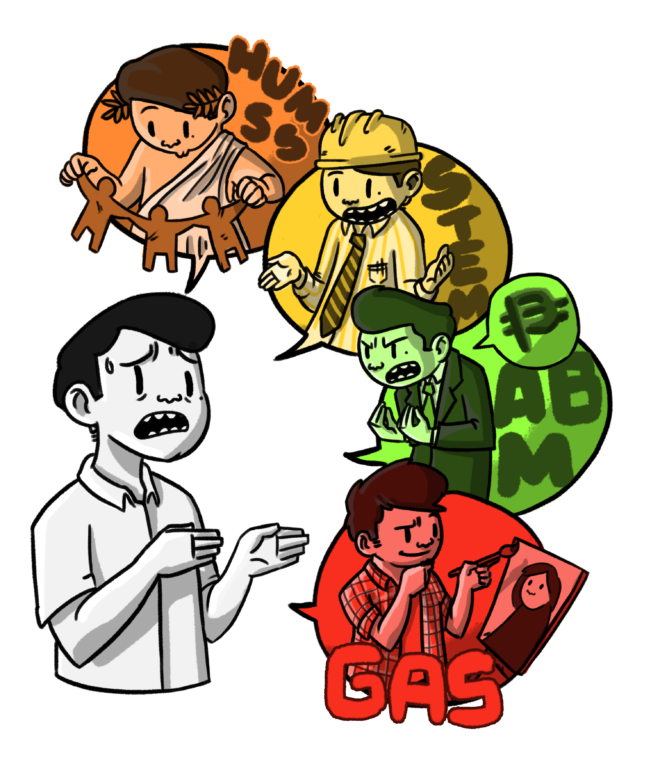Visit us on Instagram To be You; Facebook: To be You; e-mail inq.tobeyou@gmail.com

Just recently, my cousin told me about the difficulty in deciding what would be her senior high school strand.
As a Grade 11 student enrolled in STEM (Science, Technology, Engineering and Mathematics), I felt lucky to have found the strand that I’m really comfortable with. Looking back, I also had difficulty in choosing a strand last year in junior high.
My school offered only the academic track, and I had four strands to choose from. It was a struggle—one day it was STEM, another day it was ABM (Accountancy, Business and Management), and then some days it was HUMSS (Humanities and Social Sciences), or even GAS (General Academic Strand).
If my school offered nonacademic tracks like Arts and Design or Sports, I might have considered them, as well as two of my great passions—archery and theater.
To help out junior high school students with the same dilemma, I thought of listing down the factors to consider in choosing their own strand.
What are your interests?
The first question is: “What are your interests?”
In my case, I was into a bunch of things and all my diagnostic and personality tests indicated that I was suited for not just one, but a number of strands.
The reality is you will only be sure of your interests once you experience bits and pieces of each strand. In the meantime, you can consider previous subjects closest to your strand.
If you like solving math and science problems, go for STEM. If writing and debating interest you, consider HUMSS. If you appreciate bookkeeping and entrepreneurship, you may like ABM.
Your own skills and talents
Sometimes, things won’t work, despite your interest in a particular field. Thus, it’s important to consider your own skills and talents, and if you’re willing to put in time and effort to overcome the difficulties you will encounter in your chosen strand.
For instance, if you want to be a lawyer though you’re not adept at speaking or writing, who is to say you can’t take HUMSS? Or if want to be an engineer even if you’re not good in numbers, who is to say you can’t take STEM?
In any case, it’s best to choose the strand most suited to your natural abilities.
Balance
Another thing to consider is the time at your disposal and the activities on your plate that you have to balance with schoolwork.
One of the reasons I almost did not do STEM was that students in the higher batch were saying STEM was difficult and took up a lot of their time. Since I had archery, drama and out-of-school clubs, I had second thoughts about STEM.
So, unless you’re willing to sacrifice your free time, you may want to consider choosing a less demanding strand, or an entirely different track if your school offers the nonacademic variety.
When the going gets tough
Likewise, consider the other students you’ll be with in your chosen strand. It does not mean, however, that if all your friends go to ABM, you want to be there, too.
But then again, you and your classmates in the strand should get along well. Ideally you should be able to confide in them and ask help when the going gets tough and the lessons become stressful.
In short, you must find a group of classmates who share the same interests and with whom you will interact on a daily basis as you solve math problems, write papers, create a business practicum, discuss history and literature materials.
And what if your best friend goes to another strand? Well, remember that you can still stay the best of friends no matter the circumstances.
Dream job
For some, choosing the right strand is not just about making new friends and discovering new things related to a subject (like learning to make ice cream in chemistry). More important, it is about envisioning your dream job and career path.
Choosing a career is difficult in itself, but senior high school prepares you to make crucial decisions that will impact your future. In my case, since I have yet to decide which career suits me best, I felt that STEM would be most helpful.
Inner child
In the end, choosing the right strand may simply be about rediscovering one’s inner child. The problem with adolescence is that we sometimes overthink and forget the sense of wonder and inquisitiveness of a child.
I chose STEM not because I’m a math or science geek, but because, at a young age, I loved asking questions that were very much STEM in nature.
I like watching Discovery Channel and National Geographic. I love making mechanical contraptions out of paper, strings and whatever else was at home, inventing parachutes and other stuff to play with.
And I guess that, somehow, the child in me still knew what was best.












































